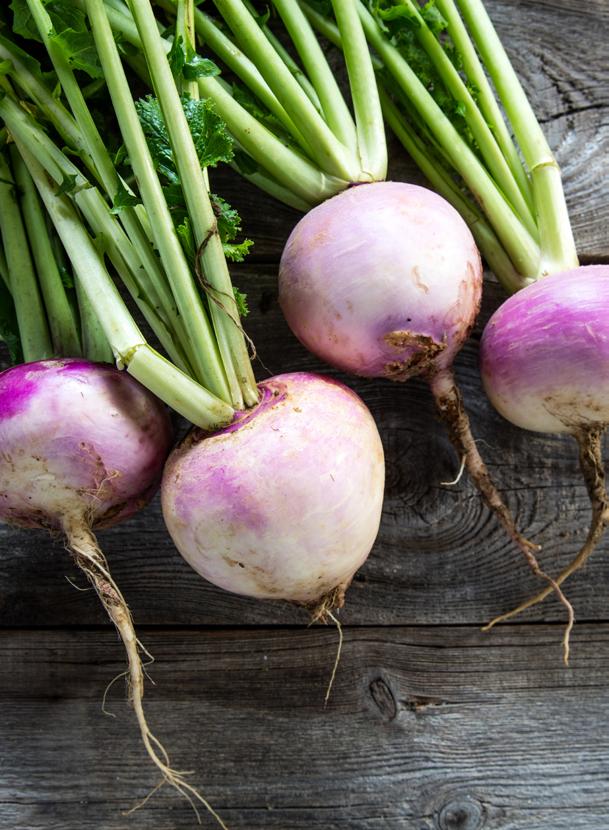
3 minute read
Inspired by Stanley Tucci
series Searching for Italy
I have been following (and enjoying) this series since the first episode, and it has just inspired me so much that I wanted to share some of the varieties and ingredients featured.
Read on to find out more about these regional varieties, how to grow them and how they are traditionally used in the kitchen.

San Marzano plum tomatoes

(Series 1:1 Naples)
Sow: Feb to May.
Very thin skin, meaty, sweet, and with very few seeds inside, this is the best cooking tomato. It is used to make passata in particular but is also used for canning, sauces, ketchups and more. The fact that this variety originates in Naples, as do both Pizze(a) and Pasta, tells you how these three things are so intricately tied together. And they are under threat, so much so that they are on the Slow Food ‘Ark of Taste,’ a register of ingredients and varieties at risk of being lost.
Basil Tigullio
(Series 2:8 Liguria/Italian Riviera)
Sow: from spring to late summer. What evokes the memory of summer best if not basil?
Most basil seed bought here is not Italian, but Franchi has basil ‘Tigullio,’ which is used to make Pesto Genovese and should be grown in the ground in May, June and July but in pots before or after that. Pesto is traditionally eaten with Trofie pasta, which catches the basil flakes; green beans to cut through the Ligurian olive oil (considered to be the best in Italy) and boiled potatoes, which will turn green as they soak up the basil oil.

Tropea Onions
(Series 2:5 Calabria)
Sow: spring for the same year and autumn for the following.
Red onions originate in Italy. The Hairy Bikers called the Tropea onion “the best onion in the world” (‘2018 Mediterranean Tour’) and it is said that it is so sweet that you can almost eat it like an apple. They add sweetness and have the most amazing flavour. They caramelise beautifully, but don’t let me talk you into buying them; just watch the episode on iPlayer at 21 mins in!

Broad Beans
(Series 2:7 Puglia)
Sow: In the winter for a spring harvest and again in the spring for an autumn harvest. They are utterly delicious but frowned upon by some, who just boil and serve them as ‘bitter.’ You can make a simple Puglian broad bean mash called N’Capriata by simply boiling two peeled potatoes with your broad beans. Remove the transparent shell from the broad beans and mash them with a good olive oil and a pinch of salt. The potatoes add sweetness and this usually served alongside a bed of boiled Catalogna chicory. This is undeniably classic ‘Cucina Povera’ (peasant food). N’Capriata also happens to be vegan.
Turnip Coletto Viola
Sow: March – July (early crop), April – mid August
While it is not featured in Searching for Italy, I wanted to highlight the bestselling turnip variety in the UK. It is Italian and stocked on Franchi seed stands in Hillier centres! In the news recently, they do get a bit of a bad rap (Blackadder springs to mind!), but like the humble Brussels sprout, if you have the right approach, they can be quite tasty.
The centre of excellence for turnip production in Italy is Milan, and the best-selling varieties in the UK are the Milan purple-top types. Milan is in the alpine north with stoney soil, warm summers and cold winters, so very much like our conditions.

A thing to remember about traditional foods, but Italian food in particular, is that it is very much based on ‘Cucina Povera,’ where there are three characteristics: it is cheap, local and filling. Turnips would have definitely fit this brief in the same way that Cornish

Pasties would have contained swede along with other local produce like lamb, onion and potato.
In the alpine regions of Italy, where we have more cows with bells on than we do olive trees, it is much more common to use butter in cooking and let’s face it, when it is -25°C, a plate of spaghetti with a drizzle of olive oil just won’t cut the mustard! One of the easiest ways to serve up turnips is to roast them in butter in a stoneware or Le Creuset type pan covered with a lid and gently fry with a pinch of salt and some French thyme. I have even had cooked mashed turnips served with butter and truffle oil, which was just delicious.
Another failsafe way to serve turnips is to pick them smaller and roast them with other root veg, such as multicoloured carrots, potatoes, onions and parsnips. Alternatively, if they are small, put some in a stew or casserole, where they will ‘melt’ into the rich gravy but not dominate it. Enjoy! Turnips are the new tomatoes!










